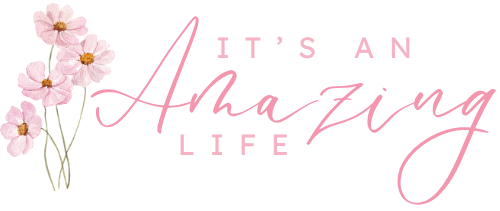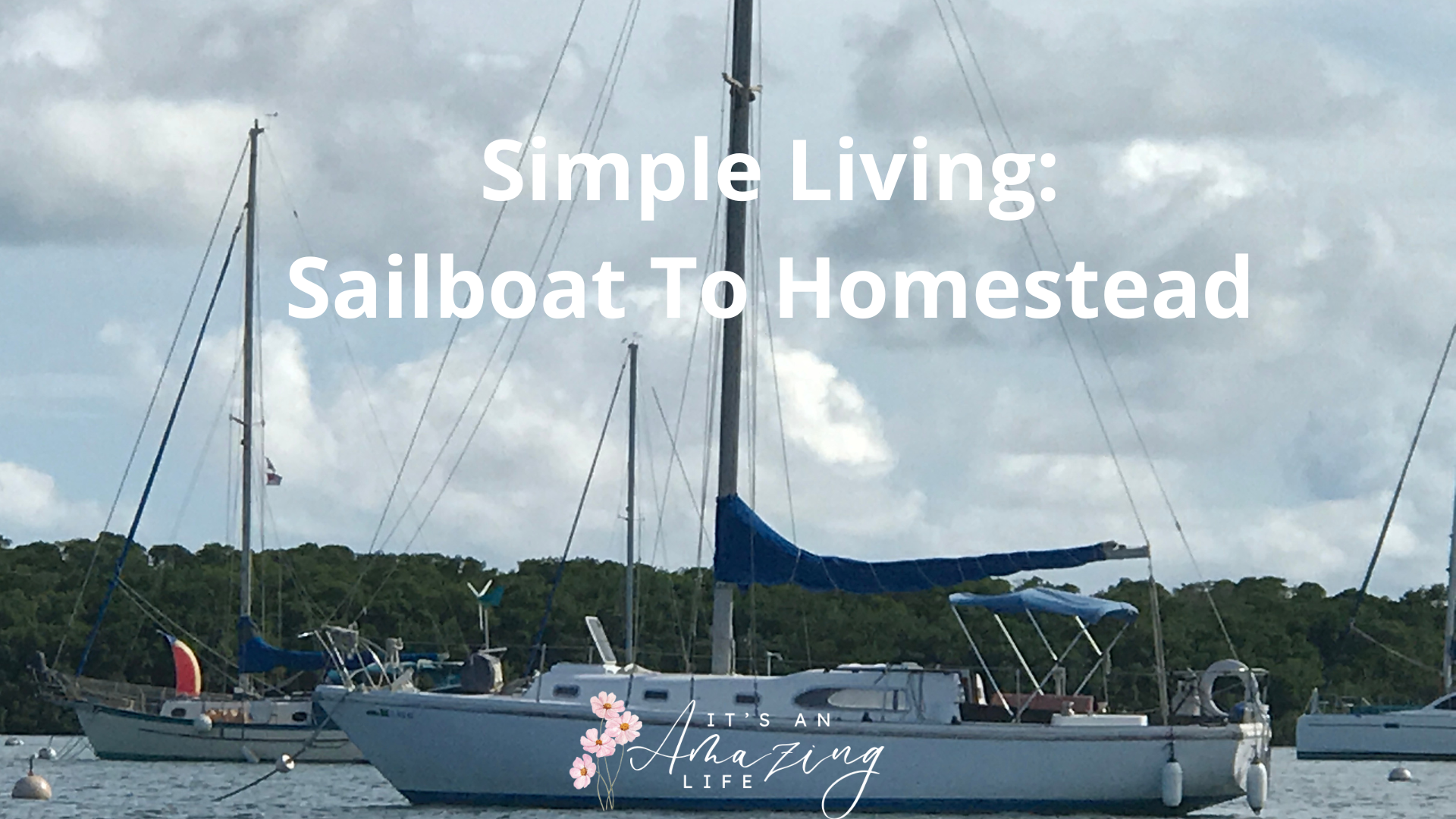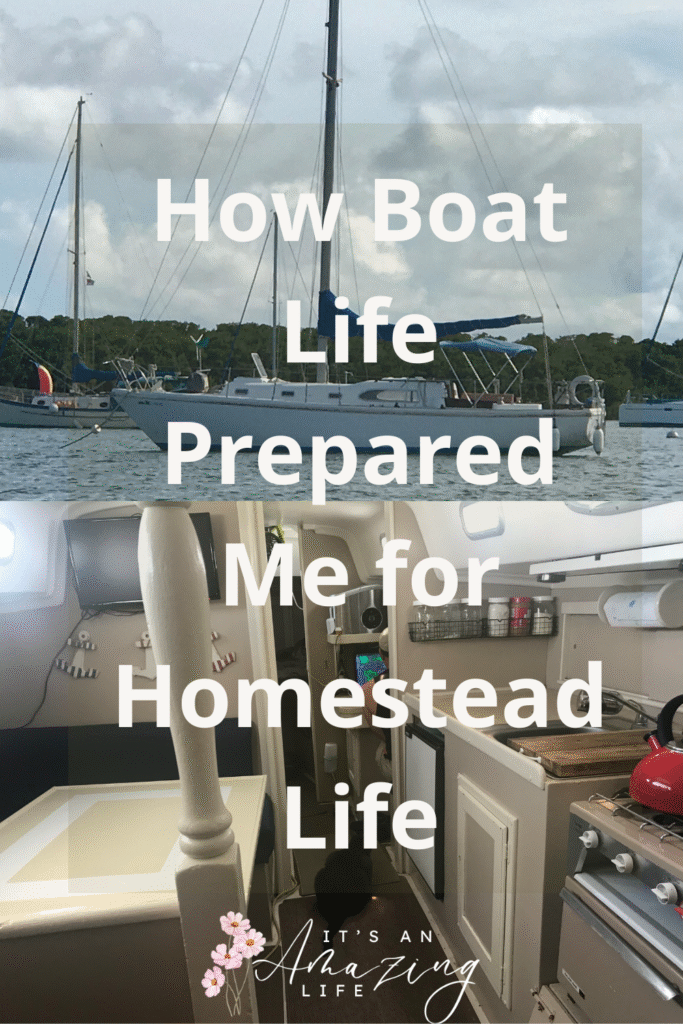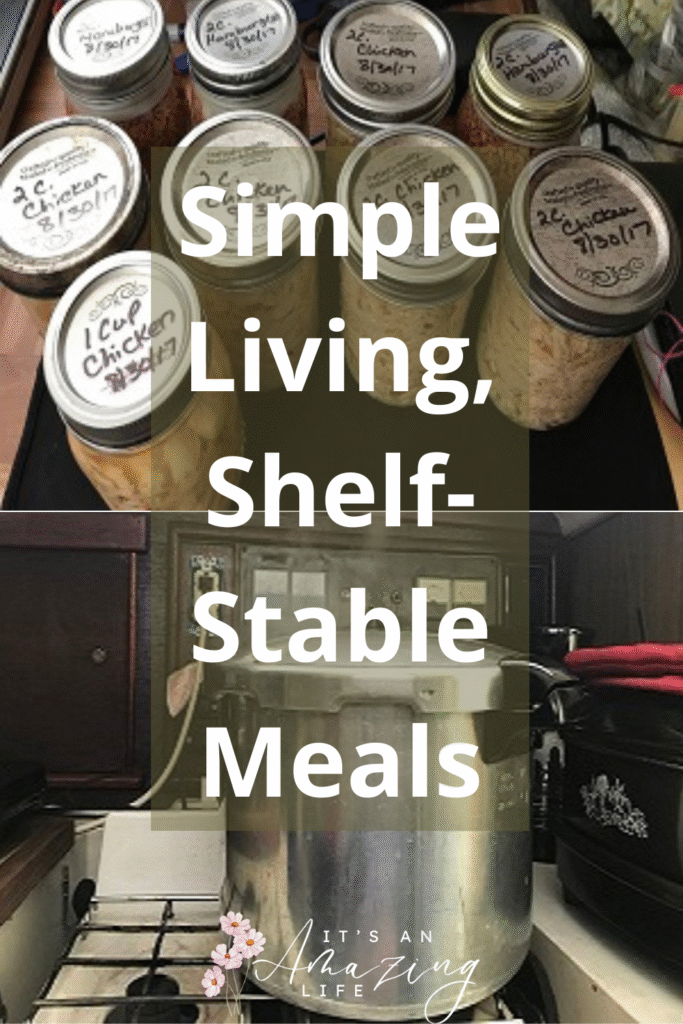I’ve lived both ways—busy and over-stuffed, and pared down with just the essentials. I learned which one gives me peace. This is the honest version of how farm life, repeated downsizing, and 3 years on a 36’ sailboat taught me simple living in real life—not as an aesthetic, but as a practical way to build the future I actually want.
Farm Roots: Simple Living Skills I Didn’t Know I’d Need
I have always been a city girl…or at least a midsize town girl and then I got a taste of living on a farm. Me and my husband (at the time) moved to a 10 acre farm outside of the town we lived in. I had land, grew food, and learned to can and preserve the food we grew. My son also raised chickens, cows and pigs on our land. I also learned first hand that it isn’t easy to catch a pig – but even a pig will stop mid flight to roll around in a mud puddle and that electric fences weren’t for touching!
I didn’t realize at the time how valuable all the lessons of raising animals and canning and preserving my own food would be. At the time though, I was working too much, glued to a computer, and not fully stepping into the life the farm offered. Still, the basics took root: grow what you can, use what you have, waste less, plan ahead. Those skills quietly waited for a season when I’d need them again.
The Downsizing Spiral: Learning Simplicity
After the farm came a smaller house in town, then another move across the US to Florida—so we downsized again. Each move forced decisions: keep, donate, sell, or throw away. Closets shrank, boxes disappeared. The surprising part? The more I let go, the less I missed. Most of what I thought I “needed” was maintenance—dusting, storing, organizing, moving. It wasn’t adding value; it was adding weight.
What that taught me about simple living:
- Stuff creates work—not just to buy it, but to clean it, store it, and think about it.
- If you don’t use it, it owns you.
- Peace shows up faster when surfaces are clear and decisions are simple.
Even now, five years back on land, the stuff creeps in again. One “good deal,” one extra set of sheets, one more box in the closet. I feel the difference immediately. Too much makes life noisy. That’s why I’m downsizing again—when the time comes and I find my homestead, I will be moving only what matters.
The Sailboat: How Constraints Taught Me Simple Living
Then came the 36’ monohull sailboat in Florida. Storage? Don’t even think about it. Our fridge was dorm-sized. Every shelf was a decision. There wasn’t room for “just in case.” Limits weren’t a theory—they were the dimensions of the cabin.
This is where farm skills came back on purpose. I pulled canning into my life again because it solved a real problem: no space for bulky cold storage. Jars on a shelf beat a full fridge. A pressure canner and some planning meant meals were ready, ingredients stayed shelf-stable, and I didn’t have to run to the store because we ran out of space for leftovers.
I remember standing in the galley on the boat with a small two-burner propane stove and that huge pressure canner while it was 90 degrees outside. Even with the AC running, lighting that stove turned the cabin into an oven. I thought, “This is miserable.” But then those jars came out, lids popping one by one, and I thought, “This is worth it.” Function over comfort — and it worked.
What that taught me about simple living:
- Function over comfort matters.
- Limited space forces creativity.
- Preparation is everything.
Was it glamorous? No. Boil water to wash dishes. Plan meals strategically. Get creative for storage. Fix things when they break. Not Instagram-worthy moments, but the backbone of a day that actually works.
Community and Simple Living: Lessons from the Dock
I didn’t move onto the boat for community, but I found it anyway. People on the dock helped us learn to tie lines, position fenders, and prepare for hurricanes. If you needed a tool, you asked. If you didn’t know how to do something, someone showed you. Conversations weren’t cursory hellos—they were real.
Simple living isn’t only about fewer things. It’s also about the right people: skills shared, hands offered, problems solved together. It fills the gaps when you don’t have every tool or every answer.
What that taught me about simple living:
- The right community multiplies your abilities.
- Knowledge exchanged beats money spent.
- Working with the right people turns effort into efficiency.
Leaving the Boat: Noticing What Was Missing
Returning to land life was loud—literally. More traffic. More neighbors packed close, but less talking. More options, but somehow more stress. The “conveniences” didn’t feel convenient. And the stuff started multiplying again—because that’s what happens when closets are available.
It took distance to see clearly: I wasn’t chasing nostalgia. I missed the function of a quieter, more intentional way to live. Fewer decisions. Fewer piles. Practical systems. And yes—more people helping people because that’s culture, not exception.
What I Actually Learned About Simple Living
Here’s what matters—and what I’m carrying forward:
1. Food preservation is leverage
Canning, preserving, and smart meal planning aren’t just hobbies—they’re practical skills that save time, money, and stress. A stocked pantry keeps life running smoothly, whether on a small boat, a tiny kitchen, or a future homestead.
2. Community is a practical asset
You can’t do everything alone. Building connections with neighbors, friends, and people who bring different skills creates a support network that makes challenges manageable and life more rewarding.
3. Creative problem-solving is essential
Limited space, unexpected challenges, and unpredictable situations forced me to think on my feet. Finding clever, resourceful solutions became second nature.
4. Resourcefulness and adaptability matter
Whether making do with what’s on hand, repurposing tools, or finding ways to stretch a budget, learning to adapt has proven critical for living efficiently and sustainably.
5. Quiet and focus fuel productivity
By being intentional about when and where I work, I can focus on the tasks that matter most. Whether I’m preserving food, tending animals, or planning a homestead project, minimizing distractions not only increases efficiency but also brings a deeper sense of satisfaction and accomplishment.
Why This Points Me Back to a Homestead
I’m not chasing a trend. I’ve tested both ends: busy and loud vs. simple and steady. I know which life supports the future I want. A homestead isn’t about collecting animals or projects for show—it’s about systems that produce sustainability: food in jars, tools that earn their space, a community who trade skills, and a pace that lets me hear myself think.
I’ve seen what works—on the farm, in small houses, and on a boat with a tiny fridge—and I’m choosing the version that holds up in real life.
The Plan (Kept Simple on Purpose)
- Downsize again. If something doesn’t have a useful purpose, it doesn’t get moved.
- Rebuild the pantry smartly. Shelf-stable first. Preserve in batches.
- Keep tools that solve repeat problems. Not gadgets I’ll use once.
- Lean on community, build connections. Share skills, ask for help, return the favor.
- Protect quiet. Schedule it if I have to. It pays for itself in clarity.
Closing It Out (No Hype)
I’ve lived with more and I’ve lived with less. Less wins—when it’s the right less: fewer things, fewer distractions, fewer decision bottlenecks, and fewer hours on the internet. More of what matters: Building community and connection with those you can count on, skills, systems, and a pace that lets you build something that lasts.
That’s why I’m moving back toward land and a homestead—not to escape, but to return to what works.
If you want to follow me on my journey save this pin and check back for more posts.



